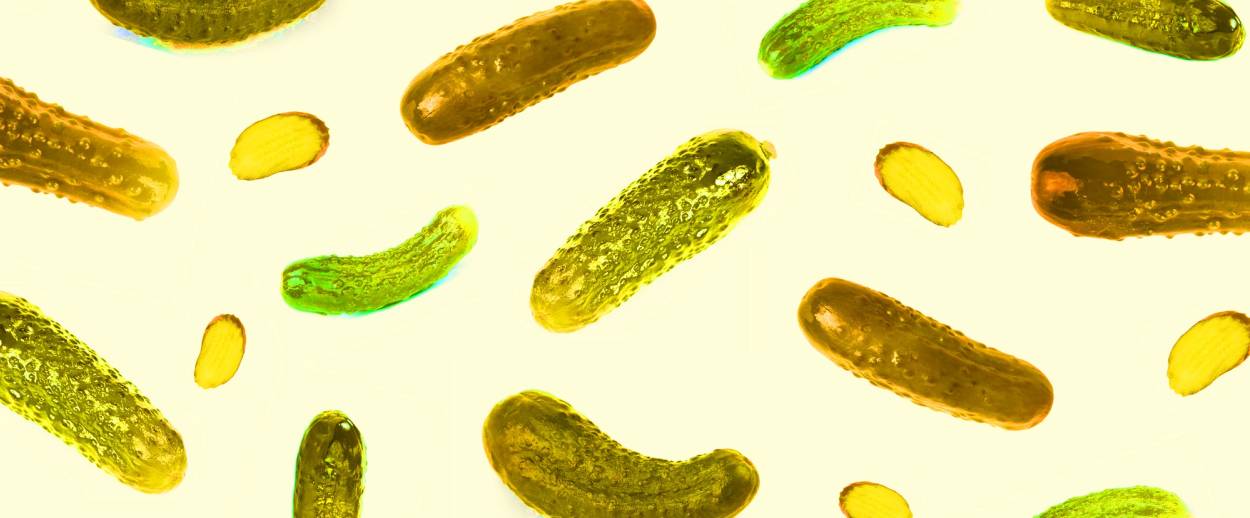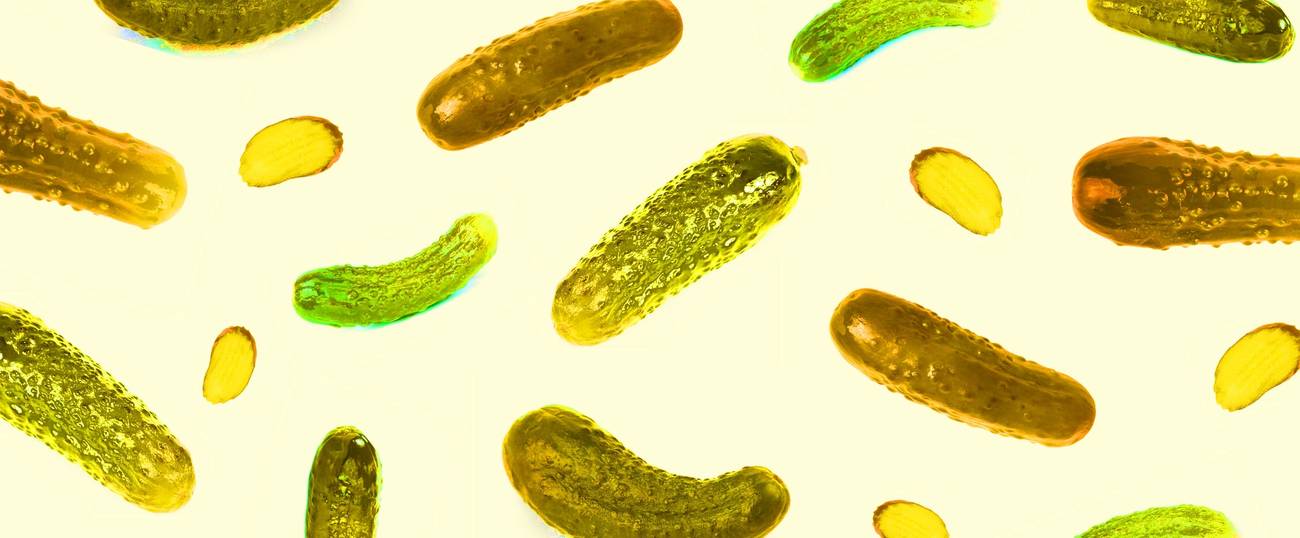For the Love of Pickles
In the heat of summer, nothing is as refreshing as a cold pickle. Just ask my kids.




Last week we picked up Maxine, 10, at sleepaway camp. The first thing she did when she walked into the house was go straight to the giant jar of pickles my husband had thoughtfully left on the counter. She wrapped her arms around it and sighed, “I think I’ve missed you most of all!”
Maxie is about as rabid a pickle fan as you’ll ever meet. The rest of us love pickles and make regular field trips to The Pickle Guys on Essex Street on the Lower East Side, but Maxie’s passion is such that we have to keep the kitchen stocked with giant jars of cheap Vlasic dills from Costco and discounted half-gallon containers of tiny gherkins from East Village Cheese. (The latter is our delightful old-school neighborhood discount fromagerie started by a Jew and now owned by a pair of Tibetans.)
My older daughter, Josie, was the original pickle fiend. She rejected her first birthday cake in favor of a pickle. Pickles are great teething devices (seriously, if there is a baby in your life, look into this), but Josie’s love went beyond the beyond. I used to bring pictures of her gnawing on Russ & Daughters’ pickles to the shop, where they’d put them on the bulletin board. I still have a voicemail message from Mark Russ Federman dubbing Josie “the official baby of Russ & Daughters.” (Now that Niki Federman is a mom herself, I assume my offspring have relinquished any claim to this title.)
Josie’s unholy love of pickles has diminished to normal proportions for our family (meaning, “still way more into pickles than most people”), but Maxie’s has gone on strong. Her favorites are The Pickle Guys’ new pickles (barely brined and bright electric green), but she’ll eat any variant, from a raw cucumber to a mouth-puckering full-sour.
Luckily, she lives in the right neighborhood. According to the Lower East Side Tenement Museum, New York’s reign as pickle capital of the world began in the 17th century, when Dutch merchants sold pickled cucumbers grown by Dutch farmers in Brooklyn to markets throughout the city. As waves of new immigrants flowed into the Lower East Side in the 19th and 20th centuries, pickles proliferated popularly. “Available year-round, cheap, and ready to eat, pickles fed tenement dwellers and reminded many Eastern Europeans of the lands they had left behind,” notes the museum’s website.
Our Eastern European forebears survived freezing winters on bread, potatoes, and pickles, according to Tablet contributor Leah Koenig. Ashkenazi Jews used to fill barrels with cucumbers, beets, and shredded cabbage every autumn, let them ferment, then move them to cool, dark cellars. Pickled vegetables held them over until spring, when fresh produce became available again.
Pickles maintained their place of primacy in Jewish culture in the new world. Mrs. Esther Levy’s Jewish Cookery Book: Principles of Economy Adapted for Jewish Housekeepers With Medicinal Recipes and Other Valuable Information Relative to Housekeeping and Domestic Management (1871), the first Jewish cookbook published in America, includes recipes for pickled cauliflower, walnuts, French beans, peaches, cabbage, onions, lemons, cucumbers (“choose the least seedy sort”), and nasturtium flowers.
But not everyone viewed pickles as a benign and tasty foodstuff. As Jane Ziegelman, director of the Tenement Museum’s culinary program and author of 97 Orchard (an “edible history” of five new immigrant families in one 20th-century building), notes, WASPier Americans saw the pickle as morally suspect. She quotes physician and author Dr. Susanna Way Dodds, who wrote in 1883: “The spices in it are bad, the vinegar is a seething mass of rottenness … and the poor little innocent cucumber … if it had very little ‘character’ in the beginning, must now fall into the ranks of the ‘totally depraved.’ ”
Jews did not get this memo. When Lower East Side public schools let children out at lunchtime, kids ran en masse to the nearest pushcarts. Social service workers were horrified. “Pickles were seen—by a nation on its way to Prohibition—as a compulsion for those too young to drink alcohol,” noted Ziegelman. They were often classified as a “stimulant,” along with coffee, tobacco, and whiskey. Another early-20th-century activist observed, “For the children of the poor there seems to be some strange fascination about pickles. One lad of 10 said that he always bought pickles with his three cents. ‘I must have pickles,’ he said.” The City’s Board of Education established school lunch in large part to wean immigrant children away from their degenerate pickle lust.
In spite of these efforts, there used to be at least 80 pickle vendors on the Lower East Side (Essex Street was nicknamed “Pickle Alley”). The name that holds the most romance to New Yorkers of a certain age is Guss. Izzy Guss, a Russian émigré, started off as a pushcart pickle vendor and then opened a shop on Hester Street in 1920. Guss’ Pickles remained in the neighborhood for generations—I remember heritage trips from Rhode Island with my synagogue and Jewish day school, when the invariable highlight was sampling Guss’ wares—but in the early 2000s, Guss’ became embroiled in legal battles with various parties laying claim to its name, recipes, and future. As the New York Post wrote in 2002, “This tale of betrayal, madness, jealousy, and rage makes King Lear sound like a child’s bedtime story.” (You can read the whole megillah here.) Today, the Guss store is gone. The Guss name is on pre-packaged pickles sold at Whole Foods (you can also buy online here), former Guss owner Patricia Fairhurst owns Clinton Hill Pickles in Brooklyn, and longtime Guss employee Alan Kaufman runs The Pickle Guys.
***
Of course we Jews are not the only pickle people. Cleopatra claimed that pickles were what made her beautiful. Aristotle praised pickles’ healing powers. Both Christopher Columbus and Amerigo Vespucci stocked their ships with pickles. Shakespeare queried, “Oh, Hamlet, how camest thou in such a pickle?” Thomas Jefferson sighed, “On a hot day in Virginia, I know nothing more comforting than a fine spiced pickle, brought up trout-like from the sparkling depths of the aromatic jar below the stairs of Aunt Sally’s cellar.” Pickles hold pride of place in Japanese and Korean cuisines. And state fairs in the Mississippi Delta introduced a new entry to the pickle pantheon: Kool-Aid-infused pickles. Americans today eat 5.2 million pounds of pickles per year. Maxine can’t account for more than a few hundred thousand, which still leaves nearly 9 pounds per person in this great nation.
Pickle brine may also be the original Gatorade. Or cortisone cream. Or both. Nolan Ryan’s record-holding 5,714-strikeout career is attributable to pickles—at least, according to the 1968 New York Times. Sportswriter Joseph Durso named pickle brine “the New York Mets’ secret weapon.” Trainer Gus Mauch used it to cure the team’s youthful pitching staff’s “very tender hands.” In particular, rookie Ryan “was always complaining that he got blisters on the middle finger of his right hand where he gripped the ball across the seams.” So, Mauch, who used to give massages to Adm. Peary and George Bernard Shaw back in the 1920s, went to the Bronx (right near Yankee Stadium!) and stocked up on pickle juice. “Brine solution toughens the skin,” he told the Times. “[I]t’d be great if I had barrels of pickle juice every day.” Trainers today swear by pickle juice as an internal remedy for athletic cramps … and actual studies back them up.
If you want to visit pickles in their original American habitat, you could come by for Lower East Side Pickle Day this Oct. 4. At this annual event, held since the late 1990s, visitors can sample pickles from a zillion purveyors of different backgrounds, buy a Pickle Day T-shirt that says, “It’s kind of a big dill,” participate in a pickle-pun-off, enter a home-pickling contest, and hope for the appearance of the pickle-brine dunk tank. My family skips it, though. It’s too damn crowded. And we have plenty of pickles at home.
***
Like this article? Sign up for our Daily Digest to get Tablet Magazine’s new content in your inbox each morning.
Marjorie Ingall is a former columnist for Tablet, the author of Mamaleh Knows Best, and a frequent contributor to the New York Times Book Review.